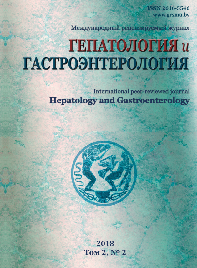COMBINATION THERAPY AS AN OPTIMAL APPROACH FOR CORRECTION OF ALCOHOL LIVER DAMAGE

Abstract
Background. Alcoholic liver damage is currently a significant social and medical problem. At this stage special attention is paid to combination therapy.
Objective. To study the effects of UDCA in combination with curcumin, betaine, metformin and bezafibrate for the correction of experimental alcoholic steatohepatitis (ASH) in rats.
Materials and methods. The experiment was carried out on rats with ASH induced by ethanol-containing diet of Lieber-DeCarli which were administered intragastrically ursodeoxycholic acid (UDCA 30 mg/kg) in combination with the following preparations: curcumin (100 mg/kg), betaine (100 mg/kg), metformin (50 mg/kg) and bezafibrate (5 mg/kg). Histological and biochemical methods were used, followed by morphometric and statistical analysis.
Results. The combined administration of the preparations contributed to the reduction of serum marker enzyme activities, serum and liver triglycerides contents, the level of proinflammatory cytokine (TNF-α) as well as to the increase of reduced glutathione, wherein the combinations were not inferior to the action of UDCA at a dose of 40 mg/kg, used as monotherapy, and in some cases surpassed it. The administration of UDCA with betaine showed a pronounced hypolipidemic and antiinflammatory effects. Combination of UDCA with curcumin and bezafibrate had a high antioxidant activity.
Conclusion. All of the studied combinations under the conditions of experimental alcoholic steatohepatitis showed hepatoprotective effect by improving the histological picture of the liver and having a positive effect on biochemical parameters and indicators of antioxidant protection.
References
1. World Health Organization. Global status report on Alcohol and health, 2014. [Internet]. Geneva: WHO; 2014. 378 p. Available from: http://apps.who.int/iris/bitstream/hand le/10665/112736/9789240692763_eng.pdf; jsessionid=C2 1EF1E214DCDC47216722CCDE09E767?sequence=1.
2. Hirschfield GM, Invernizzi P. Progress in the genetics of primary biliary cirrhosis. Seminars in Liver Disease. 2011;31(2):147-156. doi: 10.1055/s-0031-1276644.
3. Ishibashi H, Komori A, Shimoda S, Ambrosini YM, Gershwin ME, Nakamura M. Risk factors and prediction of longterm outcome in primary biliary cirrhosis. Journal Internal Medicine. 2011;50(1):1-10.
4. Harnois DM, Angulo P, Jorgensen RA, Larusso NF, Lindor KD. High dose ursodeoxycholic Acid as a therapy for patients with primary sclerosing cholangitis. American Journal of Gastroenterology. 2001;96(5):1558-1562. doi: 10.1111/j.1572-0241.2001.03777.x.
5. Xiang Z, Chen YP, Ma KF, Ye YF, Zheng L, Yang YD, Li YM, Jin X. The role of ursodeoxycholic acid in non-alcoholic steatohepatitis: a systematic review. BMC. Gastroenterology. 2013;13(1):140. doi: 10.1186/1471-230X-13-140.
6. Bettini R, Gorini M. Use of ursodeoxycholic acid combined with silymarinin the treatment of chronic ethyl-toxichepatopathy. Journal of Clinical Therapy. 2002;153(5):305-307.
7. Pelletier G, Roulot D, Davion T, Masliah C, Causse X, Oberti F, Raabe JJ, Van Lemmens C, Labadie H, Serfaty L. A randomized controlled trial of ursodeoxycholic acid in patients with alcohol-induced cirrhosis and jaundice. Hepatology. 2003;37(4):887-892. doi: 10.1053/jhep.2003.50118.
8. Smolin LA, Benevenga NJ, Berlow S. Use of betaine for the treatment of homocystinuria. Journal of Pediatrics. 1981;99(3):467-472. doi: https://www.sciencedirect.com/science/article/pii/S0022347681803526.
9. Kwon DY, Jung YS, Kim SJ, Park HK, Park JH, Kim YC. Impaired sulfur-amino acid metabolism and oxidative stress in nonalcoholic fatty liver are alleviated by betaine supplementation in rats. Journal of Nutrition. 2009;139(1):64-68. doi: 10.3945/jn.108.094771.
10. Kawakami S, Han K, Nakamura Y, Shimada K, Kitano T, Aritsuka T, Nagura T, Ohba K, Nakamura K, Fukushima M. Effects of dietary supplementation with betaine on a nonalcoholic steatohepatitis (NASH) mouse model. Journal of Nutritional Science and Vitaminology. 2012;58(5):371-375. doi: 10.3177/jnsv.58371.
11. Barbosa-de-Silva S, Souza-Mello V, Magliano D, Marnho T, Aguila M, Mandarim-de Lacerda A. Singular effects of PPAR agonists on nonalcoholic fatty liver disease of diet-induced obese mice. Journal of Life Science. 2015;127:73-81. doi: 10.1016/j.lfs.2015.02.
12. Liu F, Wang C, Zhang L, Xu Y, Jang L, Gu Y, Cao X, Zhao X, Ye J, Li Q. Metformin prevents hepatic steatosis by regulating the expression of adipose differentiation-treated protein. International Journal of Molecular Medicine. 2013;33(1):51-58. doi: 10.3892/ijmm.2013.1560.
13. Inzaugarat ME, De Matteo E, Baz P, Lucero D, Garsia CC, Ballegra EG, Daruich J, Sorda JA, Wald MR, Chernavsky AC. New evidence for the therapeutic potential of curcumin to treat nonalcoholic fatty liver disease in humans. PLoS ONE. 2017;12(3):e0172900. doi: 10.1371/journal. pone.0172900.
14. Avtandilov GG. Vvedenie v kolichestvennuju patologicheskuju morfologiju. Moscow: Medicine; 1980. 216 p. (Russian).
15. Buege JA, Aust SD. Microsomal lipid peroxidation. Methods in Enzymology. 1978;52:302-310. doi: 10.1016/S0076-6879(78)52032-6.
16. Akerboom TP, Sies H. Assay of glutathione, glutathione disulfide, and glutathione mixed disulfide in biological samples. Methods in Enzymology. 1981;77:373-382. doi: 10.1016/S0076-6879(81)77050-2.
17. Buko VU, Kuzmitskaya IA, Naruta EE, Lukivskaya OY, Kirko SN, Tauschel HD. Ursodeoxycholic acid dose dependently improves liver injury in rats fed a methionine and cholin-deficient diet. Journal of Hepatology Research. 2011;41(7):647-659. doi: 10.1111/j.1872-034X.2011.00820.x.
18. Buko VU. Lukivskaja OJa, Hoha AM; Institute for Pharmacology and Biochemistry of the National Academy of Sciences of Belarus. Metabolicheskie posledstvija alkogolnoj intoksikacii. Minsk: Belaruskaja navuka; 2005. 207 p. (Russian)
19. Gao B, Bataller R. Alcoholic liver disease: pathogenesis and new therapeutic targets. Journal of Gastroenterology. 2011;141(5):1572-1585. doi: 10.1053/j.gastro.2011.09.002.
20. Jung YS, Kim SJ, Kwon DY, Ahn CW, Kim YS, Choi DW, Kim YC. Alleviation of alcoholic liver injury by betaine involves an enhancement of antioxidant defense via regulation of sulfur amino acid metabolism. Food and Chemical Toxicology. 2013;62:292-298. doi: 10.1016/j.fct.2013.08.049.
21. Vizzutti F, Provenzano A, Galastri S, Milani S, Delogu W, Novo E, Caligiuri A, Zamara E, Arena U, Laffi G, Parola M, Pinzani M, Marra F. Curcumin limits the fibrogenic evolution of experimental steatohepatitis. Laboratory Investigation. 2010;90(1):104-115. doi: 10.1038/labinvest.2009.112.
22. Borole KD, Padalkar PH, Swami R. Assessment of antioxidant activity of metformin in ethanol induced liver damage in Sprague Dawley rats. International Journal of Basic and Clinical Pharmacology. 2016;5(2):324-328. doi: 10.18203/2319-2003.ijbcp20160739.

















1.png)






